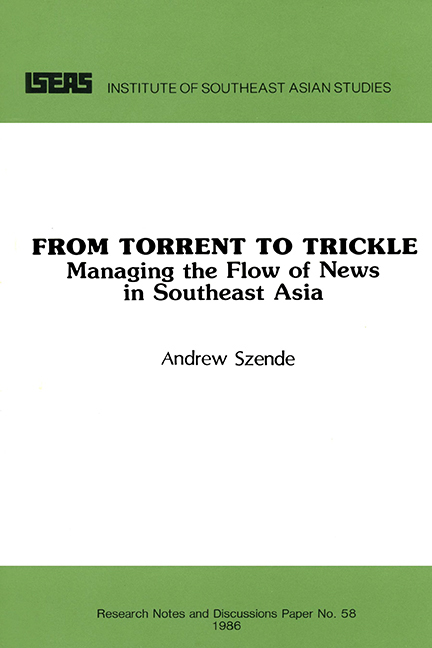III - Environmental Constraints in ASEAN
from PART 1 - INTRODUCTION
Published online by Cambridge University Press: 21 October 2015
Summary
It is necessary to recognize the basic environmental conditions of the press in the region in order to understand each country's and the ASEAN region's outlook on the news coverage provided by others. A key element in this environment is the involvement of each of the ASEAN governments in bringing the press under what national leaders consider to be appropriate supervision in the national interest. The second element is the role of national news agencies in each country's news establishment. The third element that is examined in this chapter is the attitude of each country to the circulation of foreign, including ASEAN, news, and to the work of foreign correspondents in each country.
Over the course of the brief history of the ASEAN organization, each and every one of the five countries has witnessed some form of confrontation between the government and the press. In each case, some newspapers were closed down, new rules established and the principle reiterated that the press must be in harmony with the government's aims and methods of developing the country. Even though in statements each government has encouraged constructive criticism, the experience of newspapers has been that it is much safer to retrain from criticizing if one is to be allowed to continue publishing. The basic role of the press in the region is to act as an educational medium, amplifying the views of the government and helping the public understand how the country is being developed and the role they can play in that development. In every country of the region, the press operates under licence from the government and every government has from time to time exercised its power to revoke that licence.
In Indonesia, virtually all of the papers are printed in Bahasa Indonesia, with the exception of three small papers – the Indonesia Times, the Indonesian Observer and the recently started Jakarta Post – which are in English.
- Type
- Chapter
- Information
- From Torrent to TrickleManaging the Flow of News in Southeast Asia, pp. 22 - 34Publisher: ISEAS–Yusof Ishak InstitutePrint publication year: 1986



